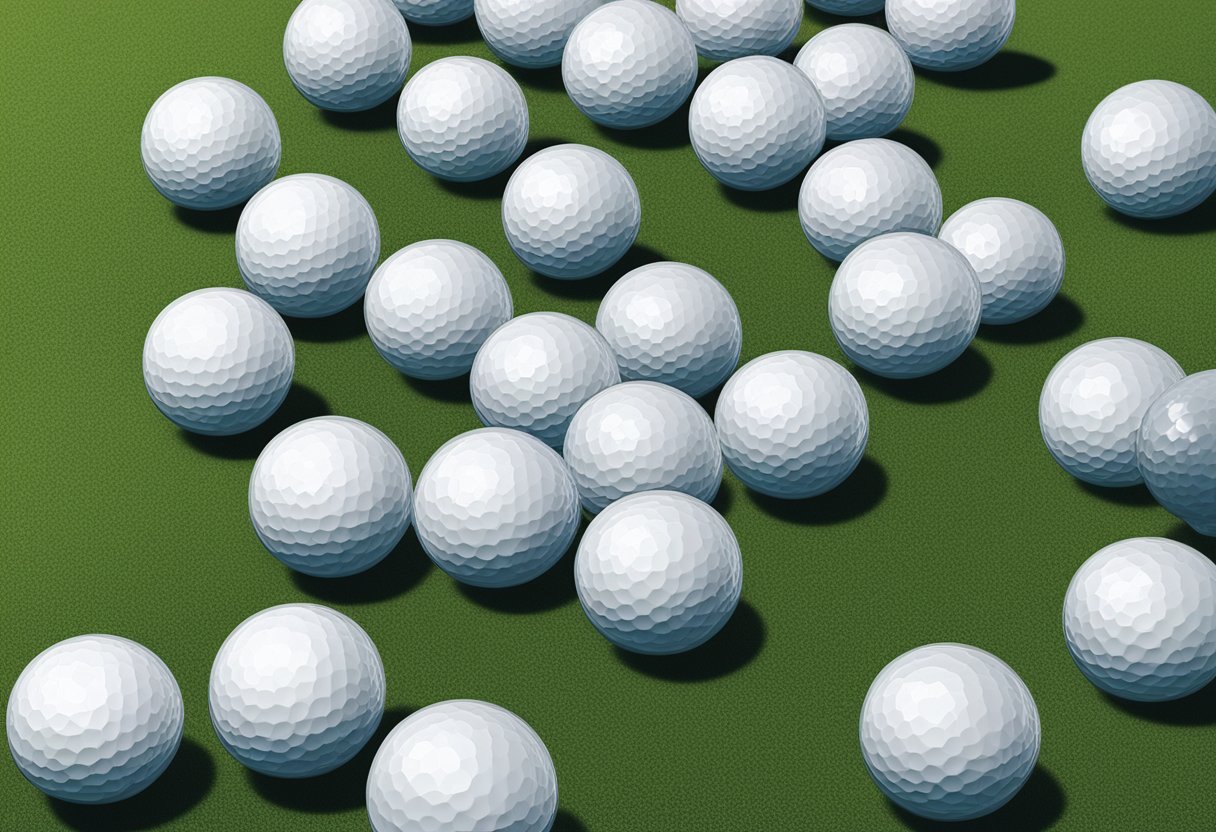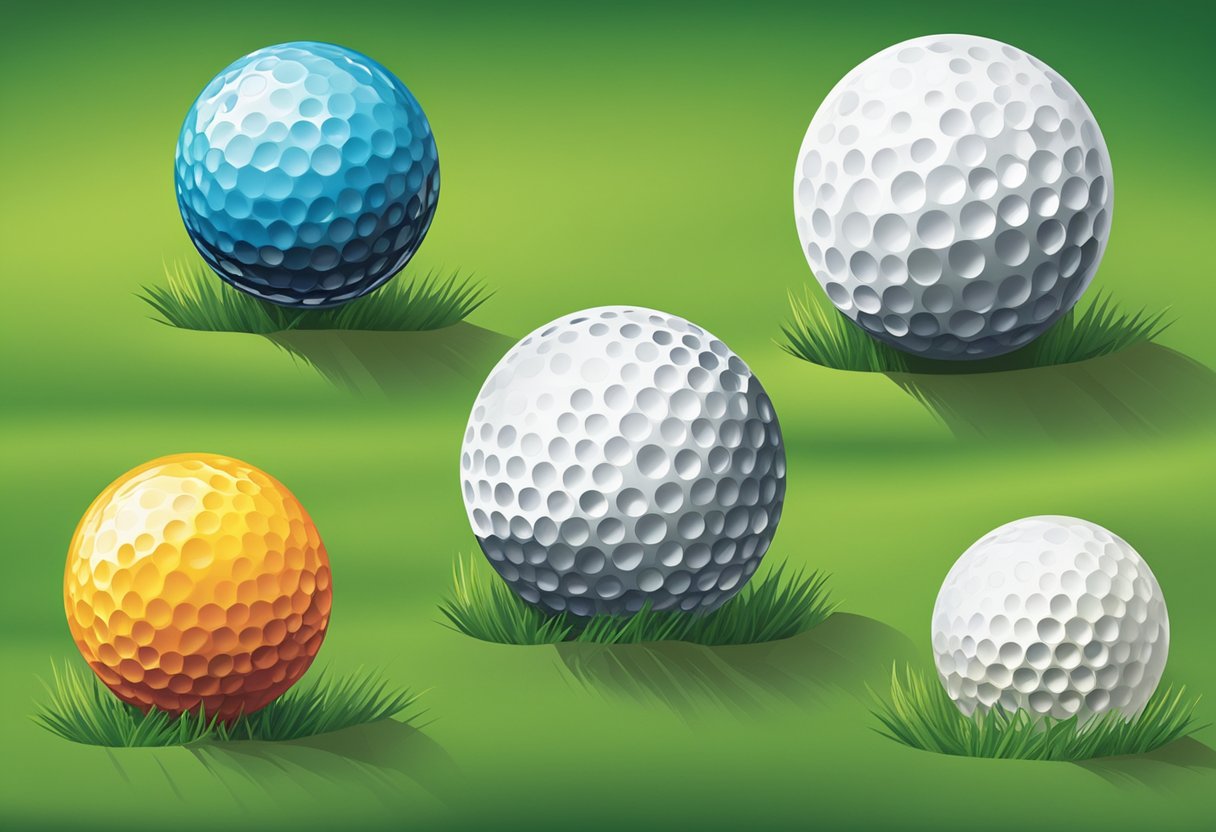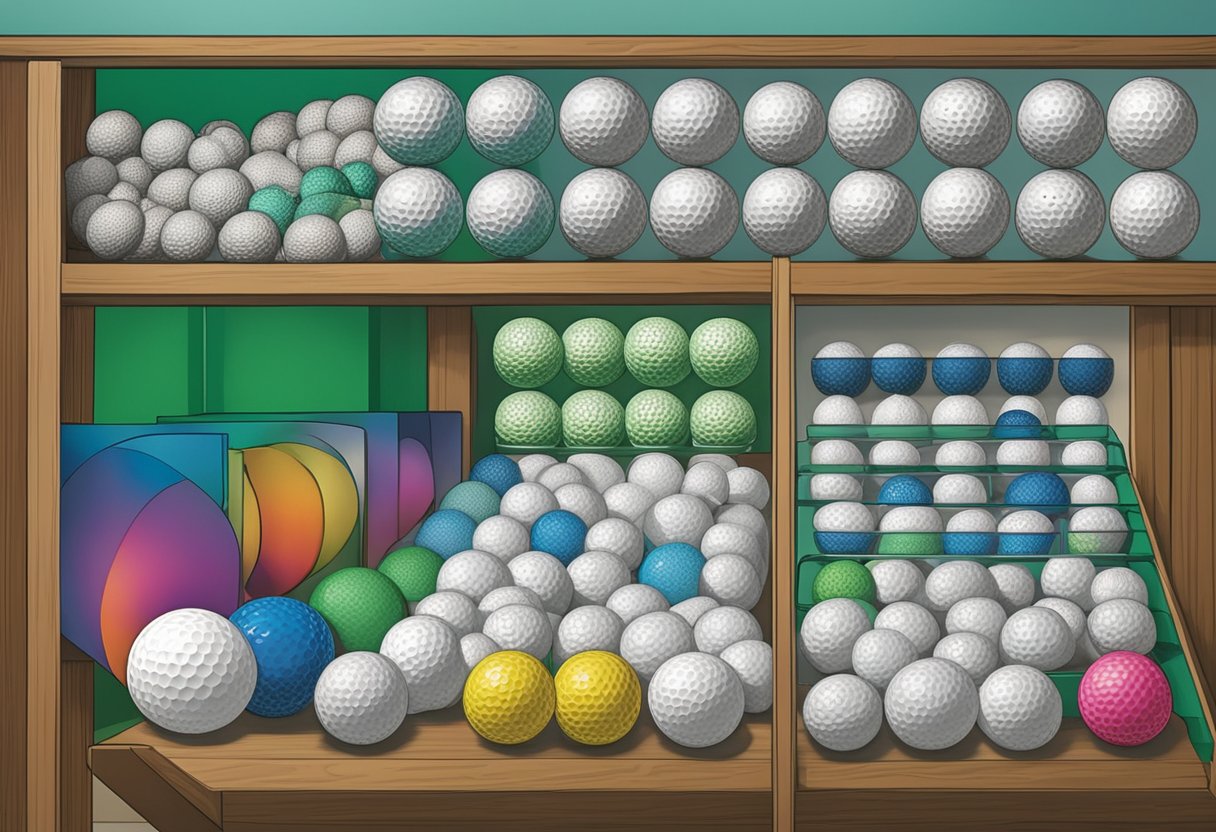If you’re a golfer, you know that choosing the right golf ball is essential for improving your game. With so many different brands, models, and types of golf balls available, it can be overwhelming to decide which one is the best fit for your individual needs. In this article, we’ll explore the factors that influence golf ball performance, the top golf ball brands and models, and specialized golf balls for specific shots.

Understanding golf ball construction is crucial for selecting the right ball for your game. Golf balls are typically made up of a core, mantle layer, and cover. The core is the center of the ball and determines its overall compression. The mantle layer surrounds the core and affects the ball’s spin rate. Finally, the cover is the outermost layer and influences the ball’s durability and feel. By understanding how these components work together, you can choose a ball that matches your swing speed and playing style.
Factors influencing golf ball performance include spin rate, launch angle, and ball speed. Depending on your skill level and playing style, you may prefer a ball that offers more or less spin, a higher or lower launch angle, and faster or slower ball speed. Other factors to consider include the ball’s compression, dimple pattern, and overall feel. By taking these factors into account, you can choose a golf ball that maximizes your performance on the course.
Key Takeaways
- Understanding golf ball construction is crucial for selecting the right ball for your game.
- Factors influencing golf ball performance include spin rate, launch angle, and ball speed.
- By taking these factors into account, you can choose a golf ball that maximizes your performance on the course.
Understanding Golf Ball Construction
When it comes to golf balls, understanding their construction is key to choosing the best one for your game. Golf balls are made up of several layers, each with a specific purpose. In this section, we’ll take a closer look at golf ball construction, including layers and materials, compression, and core.
Layers and Materials
Golf balls typically have three to five layers, each made of different materials. The outermost layer is the cover, which can be made of either ionomer or urethane. Urethane covers are more expensive but offer better feel and control, making them a popular choice for advanced players. The mantle layer is located just beneath the cover and is made of either rubber or a high-energy polymer. This layer helps to control spin and increase distance.
Compression and Core
Golf ball compression refers to how much the ball compresses when struck by a club. Low compression golf balls are softer and easier to compress, making them a good choice for players with slower swing speeds. High compression golf balls are harder and require more force to compress, making them better suited for players with faster swing speeds. The core of a golf ball can be either solid or dual-layered. Dual-core construction allows for a softer outer layer and a firmer inner layer, which can help to increase ball speed and reduce spin.
When choosing a golf ball, it’s important to consider your skill level, swing speed, and playing style. A high-end urethane-covered ball with a dual-core construction may be the best choice for a low-handicap player with a fast swing speed, while a mid-handicap player with a slower swing speed may benefit from a lower compression ball with a rubber mantle layer. Ultimately, the best golf ball for you is one that fits your game and helps you achieve your goals on the course.
Factors Influencing Golf Ball Performance
When it comes to golf, the type of ball you use can have a significant impact on your overall performance. Here are some factors that can influence golf ball performance:
Dimple Pattern and Aerodynamics
The dimple pattern on a golf ball can significantly impact its aerodynamics, which can affect the distance and accuracy of your shots. The dimples create turbulence in the air around the ball, reducing drag and allowing it to fly farther. Golf balls with larger dimples or a greater number of dimples tend to fly farther than those with smaller or fewer dimples.
Additionally, the aerodynamic pattern of the ball can affect its stability in the air. Golf balls with a more stable aerodynamic pattern will tend to fly straighter and be less affected by wind.
Spin Rate and Control
The spin rate of a golf ball can also have a significant impact on its performance. When a golf ball is struck, it will spin in the air, which can affect its trajectory and distance. Golf balls with a higher spin rate tend to have more control, allowing you to place shots more precisely and shape them around obstacles.
However, too much spin can also be a bad thing, as it can cause the ball to hook or slice more severely. Golf balls with a lower spin rate can help reduce the effects of hooks and slices, but they may not provide as much control around the greens.
Overall, finding the right golf ball for your game will depend on your individual needs and preferences. Consider factors like dimple pattern, aerodynamics, spin rate, and control when making your selection, and don’t be afraid to try out different types of golf balls to see what works best for you.
Choosing the Right Golf Ball for Your Game
When it comes to golf balls, there are a plethora of options available in the market. From soft feel to distance, compression points to slower swing speeds, there are several factors to consider when choosing the right golf ball for your game. In this section, we’ll explore some key considerations that can help you choose the right golf ball for your game.
Swing Speed and Compression Match
One of the most important factors to consider when choosing a golf ball is your swing speed. Golfers with faster swing speeds typically benefit from golf balls with higher compression points, while golfers with slower swing speeds may benefit from golf balls with lower compression points.
If you’re not sure what your swing speed is, consider visiting a local golf shop or driving range to get an accurate reading. Once you know your swing speed, you can look for golf balls that are designed to match your compression point.
Feel vs. Distance
Another important consideration when choosing a golf ball is the balance between feel and distance. Golfers who prioritize feel may prefer softer golf balls, which tend to offer more spin and control around the greens. On the other hand, golfers who prioritize distance may prefer harder golf balls, which tend to offer more distance off the tee.
It’s important to find the right balance between feel and distance for your game. Consider experimenting with different types of golf balls to find the right fit for your game.
In summary, choosing the right golf ball for your game can make a big difference in your performance on the course. By considering factors like swing speed, feel, and distance, you can find a golf ball that is tailored to your game and helps you play your best.
Top Golf Ball Brands and Models
If you’re looking for the best golf ball for your game, you have plenty of options to choose from. However, some brands and models stand out from the rest. Here are two of the top golf ball brands and models that you should consider.
Titleist Pro V1 and V1x
Titleist is one of the most popular golf ball brands in the world, and for good reason. Their Pro V1 and Pro V1x models are widely considered to be some of the best golf balls on the market. Both models offer exceptional distance, spin, and control, making them a favorite among golfers of all skill levels.
The Pro V1 is designed for golfers who want a softer feel and more spin around the greens, while the Pro V1x is designed for golfers who want a firmer feel and more distance off the tee. Both models feature a multi-component construction, with a soft core, a responsive mantle layer, and a high-performance cover.
Callaway Chrome Soft Series
Callaway is another top golf ball brand that produces high-quality golf balls. The Chrome Soft series is one of their most popular models, and for good reason. These golf balls are designed to offer exceptional distance, spin, and control, while also providing a soft feel around the greens.

« Various Ways Good Golfers Can Make Money in the Golf Industry
What is Golf Match Play? A Friendly Guide to Understanding the Format »
The Chrome Soft series features a graphene-infused Dual SoftFast Core, which provides high ball speeds and low spin off the driver, as well as a Tour Urethane cover, which provides excellent feel and control around the greens. Callaway also offers a variety of different Chrome Soft models, including the Chrome Soft X, which is designed for golfers who want a firmer feel and more distance off the tee.
When it comes to golf ball brands and models, there are plenty of options to choose from. However, if you’re looking for the best of the best, you can’t go wrong with Titleist Pro V1 and V1x or the Callaway Chrome Soft series.
Specialized Golf Balls for Specific Shots

When it comes to golf balls, there are a variety of specialized options that can help you achieve specific shots. Here are a few specialized golf balls that can help you improve your game.
Approach Shots and Greenside Control
If you’re looking for a golf ball that can help you with your approach shots and greenside control, then consider a ball with a urethane cover. Urethane cover balls offer a great combination of spin, control, and feel, making them perfect for approach shots and short game shots around the green. Some of the best urethane cover balls on the market include the Titleist Pro V1, Callaway Chrome Soft, and TaylorMade TP5.
Another option for approach shots and greenside control is a ball with a soft cover. Soft cover balls provide a softer feel and more spin, which can help you control your shots around the green. Some of the best soft cover balls on the market include the Srixon Z-Star, Bridgestone Tour B RX, and Callaway Supersoft.

Tee Shots and Long Game
If you’re looking for a golf ball that can help you with your tee shots and long game, then consider a ball with a harder cover. Harder cover balls offer less spin, which can help you achieve more distance off the tee and with your long game shots. Some of the best harder cover balls on the market include the Titleist AVX, TaylorMade TP5x, and Bridgestone Tour B X.
Another option for tee shots and long game is a ball with a low compression. Low compression balls are designed to compress more at impact, which can help you achieve more distance off the tee and with your long game shots. Some of the best low compression balls on the market include the Callaway ERC Soft, TaylorMade Soft Response, and Srixon Soft Feel.
By choosing a specialized golf ball for specific shots, you can improve your game and achieve better results on the course. Whether you’re looking for better approach shots and greenside control or more distance off the tee and with your long game shots, there’s a golf ball out there that can help you achieve your goals.
Golf Ball Selection for Different Skill Levels
When it comes to selecting the best golf ball for your game, it’s important to consider your skill level. The right ball can make a big difference in your performance on the course. Here are some tips to help you choose the right golf ball based on your skill level.
Beginners and High Handicappers
If you’re new to golf or have a high handicap, you’ll want to look for a ball that is forgiving and easy to hit. A soft, low-compression ball will help you get more distance and accuracy on your shots. Some of the best golf balls for beginners and high handicappers include the Wilson Staff Fifty Elite Golf Ball and the Callaway 2021 Supersoft.

Another important factor to consider is the price. As a beginner, you don’t want to spend a lot of money on golf balls. Look for budget-friendly options like the Taylormade Noodle Long and Soft Golf Balls.
Advanced Players and Low Handicappers
If you’re a better player with a low handicap, you’ll want to look for a ball that offers more control and spin around the greens. A high-compression ball with a urethane cover will give you the performance you need to take your game to the next level. Some of the best golf balls for advanced players and low handicappers include the Titleist Pro V1 and the Srixon Z-Star.
When selecting a golf ball, it’s important to consider your swing speed and ball flight. If you have a faster swing speed, you’ll want to look for a ball that is designed for distance like the Titleist Velocity. If you have a slower swing speed, look for a ball that is designed for maximum control and spin like the Srixon Z-Star.
Overall, the best golf ball for you will depend on your skill level, swing speed, and personal preferences. Take the time to experiment with different balls to find the one that works best for you.
Impact of Golf Ball Technology on Performance
Innovation and Trends
Golf ball technology has come a long way in recent years, with manufacturers constantly innovating and pushing the boundaries of what is possible. One of the biggest trends in golf ball technology is the use of advanced materials and manufacturing techniques to create balls that are faster, longer, and more accurate than ever before.
For example, many golf balls now feature multi-layer designs that allow for greater control over spin and launch angle, resulting in more consistent shots. Additionally, some manufacturers are experimenting with new materials like graphene, which has the potential to revolutionize the way golf balls are made.
Robot Testing and Real-World Results
Of course, all of the innovation and manufacturing capabilities in the world don’t mean much if the golf ball doesn’t perform well on the course. That’s why many manufacturers use launch monitors and robot testing to ensure that their balls are up to par.
Robot testing involves using a machine to hit golf balls in a controlled environment, allowing manufacturers to measure things like ball speed, spin rate, and launch angle. This data can then be used to fine-tune the ball’s design and ensure that it performs well in real-world conditions.
But while robot testing can provide valuable insights into a ball’s performance, it’s important to remember that real-world results are what matter most. That’s why many manufacturers also conduct extensive testing on the course, using professional golfers and amateur players alike to get a sense of how their balls perform in a variety of situations.
In the end, the best golf ball for you will depend on a variety of factors, including your swing speed, playing style, and personal preferences. But by staying up-to-date on the latest trends and innovations in golf ball technology, you can make an informed decision and find a ball that helps you play your best.

Golf Ball Cost vs. Value
When it comes to golf balls, you want to make sure you’re getting the most bang for your buck. Here are a few things to consider when weighing the cost versus value of golf balls.
Premium vs. Affordable Options
Premium golf balls can be expensive, but they often offer better consistency and performance than their more affordable counterparts. If you’re a serious golfer who demands the best, then a premium golf ball may be worth the investment. However, if you’re a beginner or casual golfer, an affordable golf ball may be a better choice. Affordable golf balls can still offer decent performance and are less expensive to replace if you lose them.
Longevity and Durability
Another factor to consider is the longevity and durability of golf balls. Premium golf balls are often designed to last longer and withstand more wear and tear than affordable golf balls. This means you may not need to replace them as often, which can save you money in the long run. However, affordable golf balls can still be durable and long-lasting, especially if you take care of them properly.
Overall, the best golf ball for you will depend on your individual needs and budget. Consider factors such as demand, value, affordability, consistency, and whether you prioritize performance or cost when making your decision.
Improving Your Game with Ball Alignment and Markings
If you want to take your golf game to the next level, you need to focus on every detail, including your golf ball. One of the easiest ways to improve your game is by using ball alignment and markings. Here are some ways that ball alignment and markings can help you improve your game:

Alignment Aids
Aligning your ball correctly can make a big difference in your game. One way to do this is by using a ball marker that will help you get the putt started on the right path. There are a ton of different ways to do this, so let’s jump into the best strategies to mark your golf ball to improve your game.
Triple Track alignment markings are one of the best ways to align your ball. These markings are designed to help you line up your putts more accurately. According to a source, the Callaway Triple Track golf ball has been designed specifically to help golfers with their alignment. It features three lines on the ball that are designed to help you line up your putts more accurately.
Visual Performance Benefits
Using ball markings can also help you improve your visual performance. According to Golf.com, some ball markings are very clever and can actually improve your putting. For example, a simple dot on the ball can help you focus on the center of the ball when you’re putting.
Another way to improve your visual performance is by using a ball with a matte finish. According to a source, matte finish golf balls have become increasingly popular in recent years. These balls have a dull finish that reduces glare and makes it easier to see the ball in flight.
If you’re serious about improving your game, consider visiting a clubfitter to help you find the right ball for your game. They can help you choose a ball that will give you the best performance based on your swing speed, launch angle, and other factors.

In conclusion, using ball alignment and markings can help you improve your game in a number of ways. Whether you’re looking to improve your alignment or your visual performance, there are plenty of options available to help you take your game to the next level.
Environmental and Manufacturing Considerations

When selecting the best golf ball, it is important to consider the environmental impact of the manufacturing process and the materials used. By choosing a golf ball that is sustainably produced and made from eco-friendly materials, you can reduce your carbon footprint and help protect the environment.
Sustainable Practices
Some golf ball manufacturers are taking steps to reduce their environmental impact by implementing sustainable practices. For example, they may use renewable energy sources to power their factories or recycle materials to reduce waste. By supporting companies that prioritize sustainability, you can help promote eco-friendly manufacturing practices within the golf industry.
Material Sourcing
Another important consideration is the materials used to make the golf ball. Traditional golf balls are typically made with a urethane cover, which is not biodegradable and can have a negative impact on the environment. However, there are now non-urethane cover balls available that are made from more eco-friendly materials.
For example, some golf balls are made with a castor oil-based cover, which is renewable and biodegradable. Others are made with recycled materials, such as old fishing nets, to reduce waste and promote recycling.
When selecting a golf ball, consider opting for one that is made with sustainable materials and has a non-urethane cover. By doing so, you can enjoy playing golf while also minimizing your impact on the environment.
Frequently Asked Questions

What are the top-rated golf balls for high handicappers in 2023?
If you’re a high handicapper, you may want to consider golf balls that offer a soft feel and extra distance. Some of the top-rated golf balls for high handicappers in 2023 include the Titleist Pro V1, Callaway Chrome Soft, and the TaylorMade TP5. These golf balls are designed to help golfers with slower swing speeds achieve more distance and accuracy.
How do I choose the right golf ball for my playing style?
Choosing the right golf ball for your playing style can be a challenge. It’s important to consider factors such as your swing speed, ball flight, and spin rate. If you have a slower swing speed, you may want to consider a softer golf ball like the Callaway Supersoft. If you have a faster swing speed, you may want to consider a harder golf ball like the Titleist Pro V1x. It’s always a good idea to test out a few different golf balls to see which one feels best for your game.
Which golf balls are recommended by professionals for distance and accuracy?
Many professional golfers use golf balls like the Titleist Pro V1, TaylorMade TP5, and the Callaway Chrome Soft for their combination of distance and accuracy. These golf balls are designed to provide golfers with the best of both worlds, allowing them to hit longer, straighter shots off the tee.
What are the benefits of using a softer golf ball like the Callaway Supersoft?
Softer golf balls like the Callaway Supersoft are designed to offer golfers a softer feel and more spin around the greens. This can be beneficial for golfers who struggle with their short game, as it allows them to get more control and precision when chipping and putting.

How do the latest Vice golf balls compare to other brands on the market?
The latest Vice golf balls are designed to offer golfers a high-quality golf ball at an affordable price. They are comparable in performance to other top-rated golf balls like the Titleist Pro V1 and the Callaway Chrome Soft, but at a lower cost.
Can you suggest some golf balls that have received high praise from Golf Digest and MyGolfSpy?
Golf Digest and MyGolfSpy have praised several golf balls in recent years. Some of the top-rated golf balls include the Titleist Pro V1, Callaway Chrome Soft, TaylorMade TP5, Bridgestone Tour B RX, and the Srixon Z-Star. These golf balls offer a combination of distance, accuracy, and feel, making them a great choice for golfers of all skill levels.







